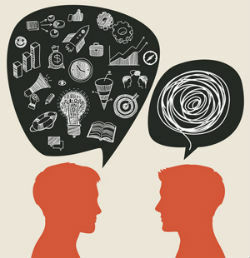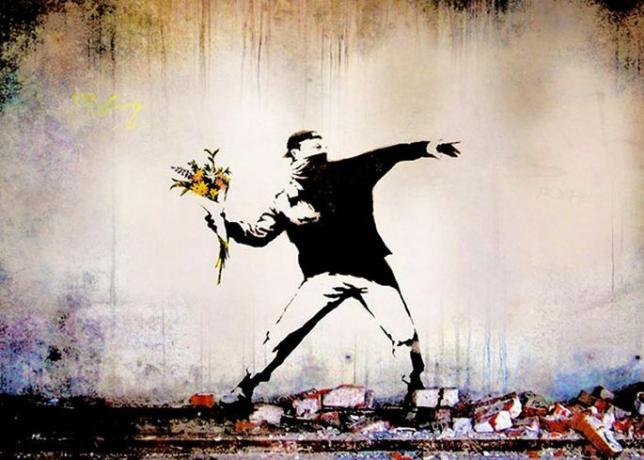Test your knowledge with exercises on cultural industry and mass culture with answers prepared by our expert teachers.
question 1
The arts were subjected to a new servitude: the rules of the capitalist market and the ideology of cultural industry, based on the idea and practice of consumption of "cultural products" manufactured in series. Works of art are commodities, like everything else under capitalism.
Marilena Chauí, Invitation to Philosophy.
According to the text, one of the characteristics of the cultural industry is:
a) commercial exploitation of works of art.
b) the appreciation of the artist and his work of art.
c) censorship of works with critical content.
d) freedom of artistic creation.
Correct alternative: a) commercial exploitation of works of art.
The cultural industry is characterized by the manufacture of products, which have cultural elements, but are intended for the market.
Thus, the relevance of the work is understood from its market value and the possibility of generating a profit for it to be sold.
question 2
For Theodor Adorno and Max Horkheimer, creators of the concept of "cultural industry", it assumes a alienating character, preventing the development of critical thinking about the exploitations suffered on the day to day.
How is this alienation produced?
a) Creating an illusion about everyday life, softening the harsh routine and developing the idea that everything is fine.
b) Creating cultural protection groups and developing actions that combat the homogeneity of cultural production.
c) Making the worker produce and consume only his own culture, oblivious to the others.
d) Homogenizing cultural production based on criteria stipulated by national governments.
Correct alternative: a) Creating an illusion about daily life, softening the harsh routine and developing the idea that everything is fine.
For the authors, the cultural industry reproduces a series of similar works that in addition to entertaining without a reflection, convey to the consumer the idea that there is no alternative to everyday life, but that "in the end", there will be an end happy.
question 3
About the cultural industry, identify the alternative incorrect:
a) It enables the democratization of access to the work of art, but, as an effect, it generates the emptying of meaning and loss of quality in artistic production.
b) The cultural industry creates forms of domination through the reproduction of an alienating model aimed at conformity with everyday life.
c) Art geared to market demands tends to reproduce itself to exhaustion, as a product that is marketed as long as there are consumers.
d) The cultural industry allows the autonomy of artists and a great complexity and diversity in productions.
Correct alternative: d) The cultural industry allows the autonomy of artists and great complexity and diversity in productions.
As its objective is the market, cultural products are easy to assimilate and consume. Thus, they require as little effort as possible, restricting the artist's autonomy and creating homogeneous models of production destined for profit.
question 4
(Unitins/2018) For the German philosophers and sociologists Theodor Adorno and Max Horkheimer, the cultural industry has as its sole objective the dependence and alienation of men. By putting make-up on the world in the advertisements it publishes, it seduces the masses into the consumption of cultural goods, so that they forget about the exploitation they suffer in production relations.
ADORNO, Theodor; HORKHEIMER, Max. The cultural industry – the Enlightenment as a mystification of the masses. In: Cultural industry and society. São Paulo: Paz e Terra, 2002.
Considering the text given, and according to the thought of Adorno and Horkheimer, it is correct to state that:
I. The cultural industry uses patterns that are repeated with the purpose of forming an aesthetic oriented towards consumerism and alienation.
II. The cultural industry promotes in individuals a pseudo-satisfaction that prevents the development of a critical view.
III. The cultural industry makes individuals its object, distancing them from conscious autonomy.
IV. The cultural industry encourages the needs of the current system, leading individuals to practice incessant consumption.
It is correct what is stated in:
a) I, II, III and IV.
b) III and IV only.
c) I and II only.
d) II and III only.
e) I and IV only.
Correct alternative: a) I, II, III and IV.
The characteristics of the cultural industry are:
- Aesthetic standardization aimed at consumption with the alienation of the spectator as a system maintenance tool.
- Decreased critical sense and absence of alternatives, generating false satisfaction and the need to adapt to the system.
- Homogenization and loss of individualities absorbed by current standards.
- Dehumanization of individuals, generating an emptying that tends to be filled by consumption.
Thus, all alternatives presented are correct.
question 5
Thus, the cultural industry, the media, mass media and mass culture emerge as functions of the phenomenon of industrialization. It is this, through the changes that it produces in the mode of production and in the form of human work, that determines a particular type of industry (cultural) and culture (that of mass), implementing in one and the other the same principles in force in economic production in general: the growing use of the machine and the submission of the human rhythm of work to the rhythm of machine; the exploitation of the worker; the division of labor.
Teixeira Coelho. What is cultural industry. São Paulo: Brasiliense, 1980.
For the author, the cultural industry and mass culture is directly linked to the mode of production:
a) Technician
b) Scientist
c) Capitalist
d) Socialist
Correct alternative: c) Capitalist
Cultural production suited to the capitalist mode of production is the foundation of cultural industry and mass culture. Thus, the main objective is not the quality of the product or the degree of freedom of creation, but is geared towards making a profit.
question 6
For Walter Benjamin, the possibility of reproducing the work of art makes it lose its “aura”, assuming a new social function.
Thus, the technical reproducibility of the work of art would allow:
a) the loss of meaning in artistic production.
b) the democratization of access to art.
c) the forgery of works.
d) the appreciation of the artist.
Correct alternative: b) the democratization of access to art.
In response to the theory developed by Adorno and Horkheimer, Walter Benjamin in his text The work of art in the era of his technical reproducibility (1935) draws attention to the possibility of democratizing art through tools for its reproduction.
Art, which can be copied and reproduced through radio, cinema, television or the press, makes it possible to reach a much larger number of people.
Thus, art would lose its “aura”, it would no longer be a ritual restricted to museums, theaters or sacred spaces and would make it easy to access the social class excluded from these spaces.
question 7
High culture, popular and mass culture are perspectives related to the forms of production, consumption and appropriation of artistic production, respectively related to:
a) ruling class, traditional and consumer-oriented manifestations.
b) higher quality, low quality and no quality.
c) authentic manifestations, demand for training and production aimed at consumption.
d) appreciation, consumption and reproduction.
Correct alternative: a) ruling class, traditional and consumer-oriented manifestations.
High culture requires preparation and cultural capital from the dominant layers. Popular culture, on the other hand, is based on the manifestation of society's customs and traditions. While mass culture is the creation of cultural products aimed at immediate and mass consumption (on a large scale).
question 8
The media play an important ideological role in maintaining the system through mass culture. The standardization of behaviors and acceptance of the current model is obtained from:
a) pluralism of ideas
b) control of public opinion
c) wide access to works of art
d) cultural Marxism
Correct alternative: b) control of public opinion
The means of communication are owned by large companies that, in the capitalist system, aim at profit. Thus, the control of public opinion is a tool for maintaining its consumer market.
Controlled individuals tend to maintain their pattern of behavior and consumption, generating profit and maintaining the current system.
question 9
For Walter Benjamin, advertising is a reflection of the change that has taken place in the relationship between individuals and art. This is because the advertisement:
a) is a new art form.
b) is used to publicize art exhibitions.
c) appropriates exclusive elements of the arts for marketing purposes.
d) develops a critical sense and selectivity of what is consumed.
Correct alternative: c) appropriates exclusive elements of the arts for marketing purposes.
Advertising appropriates the expressions, passions and feelings that were previously developed through the work of art. Thus, they create a model to seduce the viewer and generate their adhesion to the proposed ideas.
Thus, advertising becomes a tool for propagating ideologies, often aimed at market development.
question 10
(Enem/2016) Today, the cultural industry has taken on the civilizational heritage of democracy from pioneers and entrepreneurs, who also had not developed a finesse of meaning for spiritual deviations. Everyone is free to dance and have fun, just as, since the historical neutralization of religion, they are free to join any of the many sects. But the freedom of choice of ideology, which always reflects economic coercion, reveals itself in all sectors as the freedom to choose what is always the same thing.
ADORNO, T HORKHEIMER, M. Dialectics of Enlightenment: Philosophical Fragments. Rio de Janeiro: Zahar, 1985.
The freedom of choice in Western civilization, according to the analysis of the text, is a (a)
a) social legacy.
b) political heritage.
c) product of morality.
d) conquest of humanity.
e) illusion of contemporaneity.
Correct alternative: e) illusion of contemporaneity.
For the authors, the cultural industry is responsible for the false sense of freedom of choice generated. The apparent variety of cultural products hides a homogenization of content and control over actions aimed at maintaining the current system.
Thus, a characteristic of our times is the alienation of individuals, who live under the illusion that they are free to choose, but, in fact, they can only opt for standards of living and consumption previously determined by the system.
To continue studying, go to:
- cultural industry
- mass culture
- questions about culture
- Questions about Capitalism
- questions about socialism
- Questions about Karl Marx
- Questions about social movements
- Citizenship Questions
- Sociology Issues
- Questions about social inequality
- Philosophy Exercises



